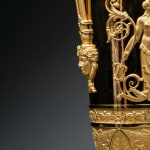Claude Galle (attributed to)
Further images
A superb and very rare pair of gilt bronze covered vases attributed to Claude Galle, each of elongated baluster form and surmounted by a domed cover with fluted finial and double handles that rise from the neck of the vase from foliate scrolls and terminate in beautiful female heads, the main body of the vase mounted by equally beautiful nude female herms with long coiled hair worn up, each with a draped lower half that continues into foliate scrolls which are held in her hands, the lower half of the body of the vase profusely cast with a ring of flower heads amid foliate motifs above upward facing lotus leaves centred by ribbon-tied floral volutes, the stepped rounded foot cast with stylised lotus leaf banding
Paris, date circa 1810
Height 44 cm. each.
Typifying the spirit and splendour of the Empire period, these superb vases are adorned with a profusion of motifs and ornaments that were inspired by the Antique. The vogue for Greco-Roman antiquities and the integration of classical design within the arts was largely due to Napoleon's chief architects and ornamentalistes Charles Percier and Pierre Fontaine whose designs, illustrated in "Recueil de Décorations Intérieures", were first published in 1801. Amongst those designs were a number of vases with handles terminating in mask heads. Other designs included fabulous female creatures with the upper body of a woman and lower half that merges into elaborate foliate scrolls, for instance adorning a tureen (pl. 34). Galle used the same female form to create wall-lights for the Charlotte rooms at the Residenz, Munich (illustrated in Hans Ottomeyer and Peter Pröschel, "Vergoldete Bronzen", 1986, p. 367, pl. 5.10.7). Similar mounts appear on a gilt bronze candelabra with Victory of circa 1805 by Galle's contemporary Pierre François Feuchère (illustrated in Ottomeyer and Pröschel, op. cit, p. 332, pl. 5.2.11) as well on a carved alcove above the main doorway to the hôtel de Monsieur and Madame Landouzy, 15 rue de l'Université - a grand Parisian residence previously owned by general Langeois d'Imbercourt (1685), Achille de Harlay (1712), d'Aligre (1716), Maupeou (1739) and Joseph de Beauharnais (1812).
A master of his craft, Claude Galle often adorned his luxury bronzes with full length female figures as well as beautiful female head masks. In particular, the features of the present heads, with their serene expressions and long hair worn up compare with those appearing at the base of the handles on a number of his ewers, of which examples can be found in the Mobilier National, at Pavlovsk and Yusupov Palace at St. Petersburg, Ostankino Palace, Moscow as well as the Württemberg Landesmuseum in Stuttgart. Again a candelabra à la Victoire, supplied by Galle in 1809 to the Grand Trianon, Versailles, features the figure of Victory that shares similar facial features (illustrated in Ottomeyer and Pröschel, op. cit, p. 335, pl. 5.2.18).
Like his rival Pierre-Philippe Thomire, Claude Galle was one of the foremost bronziers and fondeur-ciseleurs of the late Louis XVI and Empire periods. Born at Villepreux near Versailles he travelled to Paris to begin an apprenticeship under the fondeur, Pierre Foy. In 1784 Galle married Foy's daughter and then on his father-in-law's death in 1788 he took over the business which he built up into one the finest of its kind. Galle promptly moved the business to Quai de la Monnaie (renamed Quai de 1'Unité) and from 1805 operated from 60 Rue Vivienne. First listed in the trade registers in 1784 he was received as a maitre-fondeur in 1786 and promptly gained the first of many commissions from the Garde-Meuble de la Couronne under Jean Hauré from 1786-88.
He is known to have collaborated with Pierre-Philippe Thomire, amongst others, and was responsible for the majority of bronzes d'ameublement supplied during the Empire to Château de Fontainebleau. Other Imperial commissions included the supply of numerous light fittings, figural clock cases, vases and other fine bronze furnishings for the palaces at Saint-Cloud, the Trianons, Tuileries, Compiègne, Rambouillet and a number of the Italian palaces including Monte Cavallo, Rome and Stupinigi near Turin. Yet despite numerous important commissions Galle was often in debt, partly on account of his lavish life style and also since many of his clients, such as Prince Joseph Napoleon, failed to pay him. After his death Galle's business was reopened and prospered under his son, Gérard-Jean Galle (1788-1846). His work can be found among the world's finest collections including those mentioned above as well as the Musée National de Château de Malmaison, the Musée Marmottan in Paris, the Museo de Reloges at Jerez de la Frontera, the Residenz Munich and the Victoria and Albert Museum in London.





